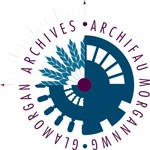The photographs selected this week from the Edwin Miles collection feature Llangynwyd Parish Church, just south of Maesteg, that is thought to date from the 6th century. Edwin Miles took photographs of many churches across Glamorgan. However, it is likely that he had a particular reason for taking the four photographs of Llangynwyd for, unusually, he added a print of a painting of the “Maid of Cefn Ydfa”.

Those who know their local history will be familiar with the story of the “Maid”. Ann Thomas was in love with thatcher and poet Wil Hopcyn. Sadly her family had already agreed that she would marry Anthony Maddox, the son of a local family, and Ann was not allowed to meet or contact Wil. In defiance of her parents she wrote secretly to Wil and the print depicts Ann hiding a letter in a tree trunk. Her family, however, insisted on the wedding and Wil eventually left Llangynwyd. Two years later Ann, only 23 years of age, fell ill, some say of a broken heart. Although Wil returned to be by her side, she died in his arms.
Little is known of Wil Hopcyn but it is thought that he was the author of the song Bugeilio’r Gwenith Gwyn and that it was written for Ann. Ann was buried in the chancel at Llangynwyd Church in June 1727. Some years later, Wil was buried in the grounds of the church.

The tale of the “Maid of Cefn Ydfa” has remained popular and was often retold by travelling theatre groups. In 1913 a film of the story was made by William Haggar and attracted huge crowds when it was shown at venues across South Wales. In October 1914, the balcony at the Gnoll Picturedome was packed well beyond capacity and collapsed during the show. It was reported that, miraculously, no-one was seriously injured and that the film was restarted and completed.
It is likely that the photographs were taken by Edwin Miles for an event held at Llangynwyd on Wednesday 20 June 1928 when a memorial cross to Wil was unveiled in the village and a new headstone installed in the church graveyard. Such was the interest in Wil Hopcyn and the “Maid of Cefn Ydfa”, that the village was flooded with thousands of visitors from across Wales keen to witness the event. If you look carefully Miles has marked two of the photographs to note that the church is the resting place of the Maid, and they may well have been sold to those attending in June 1928.
Edwin Miles took photographs of many towns and villages across the Vale of Glamorgan between 1905 and 1929. The photographs of the “Maid of Cefn Ydfa” and the Llangynwyd Parish Church, known as St Cynwyd’s, can be found under reference D261/M301-M306. We plan to feature more photographs from the Edwin Miles collection over the coming months. The main collection can be seen at Glamorgan Archives or online in the catalogue at http://calmview.cardiff.gov.uk/ under reference D261.
Tony Peters, Glamorgan Archives Volunteer





